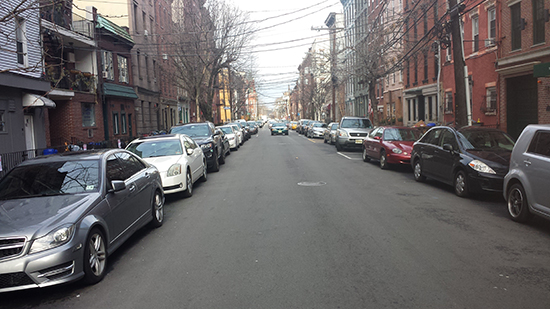By Ron Hine | FBW | January 6, 2017
Hoboken has been dubbed the “Miracle Mile.” It is a densely-populated mile-square urban area that is eminently walkable whether for shopping, eating out or recreation. Hoboken, more than any other New Jersey city, enjoys easy access to mass transit. Sixty-eight percent of the city’s workforce takes public transportation or walks to work. From Hoboken, New York City is just five minutes away via ferry and ten minutes via the PATH train or bus. The sleek Hudson-Bergen Light Rail system provides transport to Jersey City and Bayonne to the south and Weehawken, Union City and North Bergen to the north.
In Hoboken, 34 percent of households have no car. Only one-quarter of Hoboken workers drive to work, compared to three-quarters of all New Jersey residents. Being car-less in Hoboken is not such a problem for there are many alternatives available for rentals including Zipcars. And now an Uber or Lyft driver is easily summoned via one’s smartphone.
Yet, one of the biggest complaints of Hoboken residents is the difficulty of finding a parking spot on the street, preferably in front of one’s house. In response to these complaints, most developments are required by the local zoning code to provide one off-street parking space for each dwelling unit. As Hoboken has continued to grow and develop, the number of cars has grown as well. The percent of households with a car has grown steadily. With parking provided within one’s building, one can drive without fear of losing a parking spot. The result can be seen on Hoboken’s streets: more parking means more cars and thus, more traffic.
For Hoboken residents who drive to work in their cars, rush-hour delays and gridlock are increasingly common. There are limited means of ingress and egress at both ends of town. To the south, there is traffic at the Holland Tunnel and to the north, the Lincoln Tunnel. The intensive development of New Jersey’s Hudson River waterfront from Jersey City all the way up to Fort Lee has made traffic woes worsen. The good news is that the difficulties in driving and parking provide a strong incentive to walk and use mass transit.
In Manhattan, one of the developers of the 17.4 million square foot Hudson Yards project claims it is the largest private real estate development projects in American history. When completed, it will consist of 5,000 housing units, five office towers, an entertainment venue and a massive retail center. According to a March 2015 article in Politico, the developers are not required to provide for parking and so far, have built a limited number of off-street parking spaces. In the article, the authors write: “That anything of this scale—and built near the Lincoln Tunnel and the West Side Highway—would eschew parking in this way is a clear testament to how much New York City has changed. As public transit options expand, and millennials continue to skew trends away from car ownership, the necessity for buildings to supply parking is dwindling.”
The City of New York’s parking requirements are currently being overhauled. In the Politico article, Juliette Michaelson, a vice president at the Regional Plan Association, states, “These rules are from a time when people thought it was the government’s role to encourage driving. In a time when we have a huge demand for housing, but are trying to reduce driving and therefore parking, eliminating a minimum parking requirement could be a big deal.” Last year, the City of New York reduced parking requirements throughout the City for market, affordable and senior housing. Further reductions may be undertaken within designated “transit zones.”

The streets of Hoboken are filled with parked cars. With the addition of thousands of off-street parking spots over the past several decades, traffic woes have worsened.
The City of Hoboken recognized the wisdom in reducing the parking ratio for the Hoboken Rail Yards Redevelopment Area due to the fact that it was located adjacent to the multi-modal transportation hub at the Hoboken Terminal.
A new hotel proposed at Hoboken’s south waterfront, just a block from this hub, could be built without on-site parking. Typical of similar hotels in the area, only 25% of the hotel rooms would require a parking space. There is already an excess of available parking in the neighborhood. The three municipal garages on Hudson Street provide over 1800 parking spaces and the underground parking for the new buildings along Sinatra Drive nearly doubles that number. The greatest demand for hotel parking, on evenings and weekends, coincides with the lowest demand for public parking. The developer has proposed off-site valet parking.
Yet, the City of Hoboken’s overall policy appears to be inviting rather than discouraging car use. The one to one parking ratio is still in effect for most of Hoboken, especially areas that are ripe for new development. Disregarding models for good urban design, the Hoboken City Council recently approved a municipal parking garage directly across from five acres of land acquired for a park in the sparsely-populated northwest section of Hoboken. As this neighborhood is developed, there is an opportunity for builders to provide parking behind residential and retail units, thus preserving a lively and attractive streetscape that exists throughout most of Hoboken. Reducing the parking requirements would aid in this goal.
Other cities across the country are getting smarter about parking in order to reduce car traffic and encourage the use of mass transit. Chicago has reduced or eliminated parking requirements for transit-oriented development. Washington, D.C. reduced parking requirements for multi-family buildings and commercial buildings near metro stations and along high-speed bus routes. Seattle has eliminated parking requirements in much of the city, starting with commercial buildings and including residential neighborhoods with good access to public transit.
Related links
Politico: As parking needs fall City Hall weighs reduced requirements
City should base BASF park on successful models
Planning principles: streetscapes – dead or alive
Hotel would be vast improvement for premiere site at Hoboken waterfront
